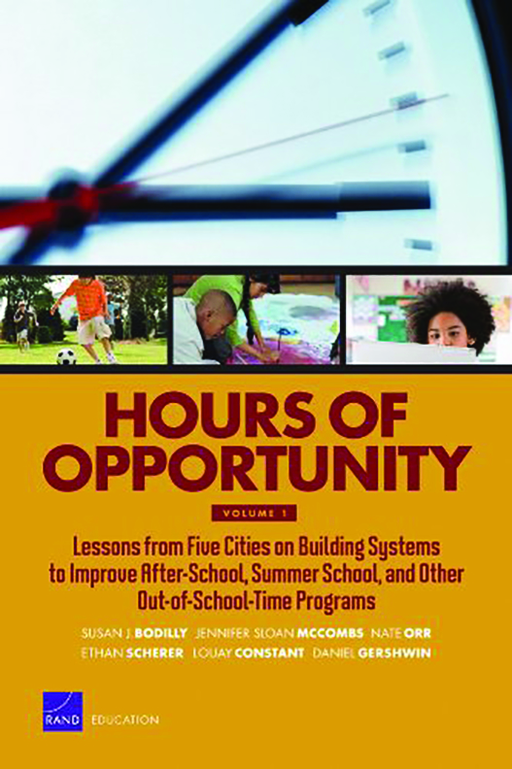Breadcrumb
- Wallace
- Reports
- Hours Of Opportunity Lessons Fro...
Hours of Opportunity
Lessons from Five Cities on Building Systems to Improve After-School, Summer, and Other Out-of-School-Time Programs (Volumes I, II, and III)

- Author(s)
- Susan J. Bodilly, Jennifer Sloan McCombs, Nate Orr, Ethan Scherer, Louay Constant, and Daniel Gershwin
- Publisher(s)
- RAND Corporation
- DOI Link
- https://doi.org/10.7249/MG1037
Summary
How we did this
Researchers from the RAND Corp. used a qualitative approach to examine efforts in five cities, supported by The Wallace Foundation, to develop community-wide out-of-school-time systems. A literature review of collaborative interagency reform efforts in the out-of-school-time and other social service sectors helped guide research steps including the development of research questions and data collection instruments as well as interviews with key city leaders, leaders of community-based organizations, principals, providers, and Wallace Foundation staff members.
What happens when schools, parks, nonprofits, and other organizations involved in out-of-school-time (OST) programs successfully coordinate their activities in a citywide effort?
Both the quality of and access to programs improve.
That was a key finding of a major, three-part report about a multi-year initiative in five cities to build citywide systems of high-quality OST programs. The initiative was funded by The Wallace Foundation. Volume I of the report surveys factors that help and hinder these efforts. Volume II examines the use of data systems in Wallace-supported and other efforts. And Volume III profiles the five ventures.
The report’s chief insight is that, despite challenges, the various organizations and institutions within a city with a hand in OST programming can work together to make services better. For example, four of the five cities increased the number of students served.
Main Objectives
The initiative had four key goals:
- Increasing access to and participation in OST programs
- Improving the quality of OST programs
- Building an information, technology, and communication infrastructure to better manage and support OST programs
- Working toward financial sustainability for OST programs and the systems designed to support them.
Multiple Activities
To achieve these goals, the sites took a variety of steps, which inspired a shared vision among the collaborators. That paid off significantly in the later years of the initiative.
Some of these activities were:
- Collecting and analyzing data to identify gaps in programming
- Consolidating functions within specific agencies
- Setting up a coordination structure, such as a steering committee, to ensure regular meetings
- Giving a special adviser the power and authority to ensure interagency cooperation
- Establishing memoranda of understanding across agencies to document specific agreements on the sharing of resources and interpretation of policy
- Creating structures for cross-agency information sharing used in joint decision making
- Providing incentives and support for coordination.
Mayors and their representatives proved to be crucial to successful collaboration and system building. Actions by mayors included restructuring agencies, increasing funding in the city budget, and demanding progress reports. A recession, with its related drop in city and state budgets, was underway by the end of the study. That significantly challenged the cities’ efforts to expand access, in particular.
Key Takeaways
- By coordinating their efforts, schools, nonprofits, funders, and other institutions can improve out-of-school-time programming.
- Strong commitment from a city’s mayor is key to OST system building.
- Taking a variety of steps, such as consolidating functions within specific agencies, is important.

This initiative provided a proof of principle—that organizations across cities could work together toward increasing access, quality, data-based decisionmaking, and sustainability.
Hear from the Programs
Materials & Downloads
What We Don't Know
- What were the effects of these efforts on students and families?

